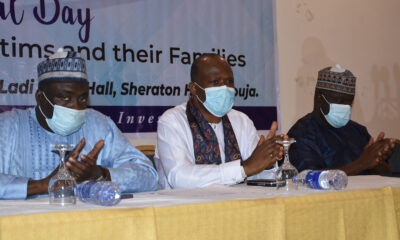Opinion
Drug Abuse: Bayelsa State At A Tipping Point? (I)

Last week, almost every major national daily reported the death of 30-year-old Daniel Celestine over a suspected drug overdose. While reporting the story, one newspaper reeled out a litany of similar circumstances in which other youths have recently lost their lives in Bayelsa State. With a little sifting of news headlines in the past four months, it became undoubtedly clear that something was amiss in the fight against drug trafficking and addiction in the Glory of all Lands. In the first instance, the current case was not that of a known addict or drug user, but a laundryman who ate food laced with a drug popularly known as Colorado at a birthday party. Only recently, a 300-level student of Petroleum and Gas Engineering at the Federal University, Otuoke, was reported to have died due to a drug overdose. But before that, a 200-level student from the same university was reported to have died in the swimming pool area of a hotel in Ogbia Local Government of the same state.
Last December, the story was also reported of the death of four internet fraudsters, popularly known as Yahoo-boys on account of a drug overdose. According to the police report, the incident occurred while they were celebrating an illicit financial windfall. Speaking to newsmen at the time of the incident, the State’s Commissioner of Police, Mr Benjamin Okolo, confirmed that the yahoo-boys died of drug-related complications after interrogating a friend who survived because of the limited amount of the drug he took. In spite of what I might refer to as the ‘garage’ of members of the National Drug Law Enforcement Agency in Bayelsa State, there is palpable fear amongst residents of Yenagoa, especially. Their fear is that a deadly threshold has been crossed in the war against drugs and that the traffickers are apparently having the upper hand. In other words, the state is at a tipping point. Already, residents are calling on the authorities of the National Drug Law Enforcement Agency, NDLEA, and the Bayelsa State Police Command, to rise up to their responsibility and investigate the source of the killer- drugs referred to as “Colors”. For most residents, the NDLEA personnel in the state are deeply engrossed in illegality rather than the task of fishing out the traffickers destroying the state with deadly drugs.
As it stands now, youths are able to access all kinds of hard drugs on the streets, including Black Mamba or Colorado, Arizona, King Louis XIII, Gelato or Larry Bird, Forbidden Fruits, Gutter Juice, Cocaine, Heroin, Amphetamine, Ecstasy Marijuana, and other psychoactive drugs. The greater evil is the alarming rate at which young people are resorting to potent mixtures despite the high risk of fatal overdose. In The Tipping Point, acclaimed journalist and bestselling author, Malcolm Gladwell, described the concept of the tipping point as that magic moment when an idea, trend, or social behaviour crosses a threshold, tips, and spreads like wildfire. Just as a single sick person can start an epidemic of the flu, so too can a small but precisely targeted push cause a fashion trend, the popularity of a new product, or a drop in the crime rate. But in this case, the frequency of drug-related mortality in the State of Bayelsa is signposting an epidemic.
During a trip to Yenagoa last December, I was not sure of what to make of the NDLEA personnel I saw mounting checkpoints on major roads. It seemed completely out of place at the time, but in light of recent drug-related deaths in the state, it is all beginning to make sense. They already knew the state has been flooded with all manner of synthetic drugs, but I doubt if what I saw them doing on the roads of Yenagoa made any difference, given our present reality. At this point, the Governor, the NDLEA, and other security agencies in Bayelsa State should be worried, but parents, especially those with children in the universities should be the most worried. Why? They ought to be worried because what is being reported on the news is only the tip of the iceberg. If the general estimate is that only 10 percent of news is reported, then the number of deaths reported so far in 2023 does not bud well.
In the 2018 National Survey on Drug Use and Health, conducted by the National Bureau of Statistics (NBS) and the Centre for Research and Information on Substance Abuse (CRISA), it was reported that South–South Nigeria had the highest prevalence rate of any drug use than any other zone in the country, with 16.6 percent or 2.1 million people aged 15-64 years in the region. Apparently, in 2023, Bayelsa is the epicentre. Many experts have theorised on the reasons for the high prevalence rate of drug abuse, or what has been termed the social determinants of drug use; and interestingly, the reasons or determinants are not markedly different from country to country, and in our own case, from state to state. Therefore, what might lead to an uptick in drug addiction in Rivers State would to a very huge extent apply in Bayelsa. This is more reason why the drug epidemic in Bayelsa State should be a major concern of every state in the Niger Delta, especially in light of the 2018 drug use report.
Multiple studies have revealed that people abuse drugs for a myriad of reasons; however, most of the reasons could be summarised under the following headings: Curiosity and peer pressure, especially among school children and young adults; the use of prescription drugs that were originally intended to target pain relief may have turned into recreational use and become addictive; chemicals may be used as part of religious practices or ritual; recreational purposes; as a means of obtaining creative inspiration; increased performance; to drive pleasure; and to enable relaxation or sleep.The 2018 survey also reports that the social consequences of drug use are very evident in Nigeria. According to the report, “key informants considered that there were major social problems such as disruption in family lives, loss in productivity and legal problems as a consequence of drug use in their communities. Also, nearly one in eight persons in the general population had experienced consequences due to other people’s drug use in their families, workplace, and communities.” The distressing part is that whatever the reason for drug use, in the final analysis, it ends up destroying the user and hurting their loved ones.
Driving this point home, the President of The Drug Salvation Foundation, Mr. Wilson Ighodalo, once commented that: “Drug abuse decreases a person’s productivity and challenges a community’s sense of security, love, and peace with one of the key impacts of illicit drug use on the society being the negative health consequences experienced by its users. They are susceptible to high blood pressure, depression, HIV, and mental illness”. If the future must be secured, then our state governments and the NDLEA in Bayelsa State cannot afford to go about the drug war as before, with the same ideology and tools that are unable to produce results in terms of saving lives by arresting addiction before it takes root.
To be continued in our next edition.
By: Raphael Pepple
Opinion
The Girl Who Didn’t Dance
Opinion
Tradition or idolatry? The Debate Over Nhe-Ajoku

Opinion
Fubara’s Strategic Masterstroke

-
Sports2 days ago
Insurance Beat Pillars In A Dramatic Way
-
Ict/Telecom2 days ago
Expert Tasks Nigerians On AI
-

 Business2 days ago
Business2 days agoVDM, Mr Jollof’ll Face The Law – NCAA
-
Rivers2 days ago
Navy Targets Training Reforms To Boost Maritime Operations
-
Politics3 days ago
PDP, ADC Fault FG Over Kebbi School Attack
-
Sports2 days ago
S’Eagles Coach Accuses Congo Of Voodoo After Loss
-
Business2 days ago
2025 LITF: Lagos Promises MSMEs Continued Visibility, Capacity Building
-
Ict/Telecom2 days ago
NCC Assures Safe, Accessible Digital Space

